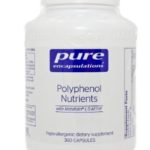Polyphenol Nutrients
Pure Encapsulations
120 capsules $48.80
360 capsules $82.10

Now with Metafolin® L-5-MTHF Powerful polyphenol-rich multivitamin and multimineral formula with additional protection factors *Packed with flavonoids and phenolic compounds from a unique blend of olive fruit, grape seed, pomegranate, green tea, quercetin and blueberry, this formula offers powerful overall cellular protection. It also contains the protective nutrients alpha lipoic acid, NAC, inositol and choline to complement the neural, cognitive, cardiovascular, liver and skin health properties of this diverse profile. Furthermore, Polyphenol Nutrients provides the advanced mineral delivery systems and active vitamin cofactors found in Nutrient 950® and UltraNutrient® for optimal bioavailability and utilization. As part of a well-balanced diet that is low in saturated fat and cholesterol, folic acid, vitamin B6 and vitamin B12 may reduce the risk of vascular disease.† †FDA evaluated the above claim and found that while it is known that diets low in saturated fats and cholesterol reduce the risk of heart disease and other vascular diseases, the evidence in support of the above claim is inconclusive. Polyphenol Nutrients is a nutrient dense multivitamin and mineral formula enhanced with an exceptional combination of polyphenols and specialized compounds for extensive physiological protection.
Servings Per Container: 30
Take 4–6 capsules per day, in divided doses, with meals.
Serving Size: 6 vegetable capsules
Amount Per Serving
vitamin A … 7, 500IU
(as beta carotene)
vitamin C … 500mg
(as ascorbic acid)
vitamin D … 800IU
(as cholecalciferol)(D3)
vitamin E … 100IU
(as d-alpha tocopherol succinate)
thiamin … 50mg
(as thiamin HCl)(B1)
riboflavin … 25mg
(vitamin B2)
niacin … 75mg
(as niacin and 67% niacinamide)
vitamin B6 … 12.5mg
(as pyridoxine HCl)
folate … 800mcg
(as Metafolin®, L-5-MTHF)
vitamin B12 … 500mcg
(as methylcobalamin)
biotin … 800mcg
pantothenic acid … 50mg
(as calcium pantothenate)(B5)
calcium … 300mg
(as calcium citrate)
iodine … 200mcg
(as potassium iodide)
magnesium … 150mg
(as magnesium citrate)
zinc … 15mg
(as zinc picolinate)
selenium … 200mcg
(as selenomethionine)
copper … 2mg
(as copper glycinate)
manganese … 5mg
(as manganese aspartate)
chromium … 100mcg
(as chromium polynicotinate)
molybdenum … 100mcg
(as molybdenum aspartate)
potassium … 99mg
(as potassium aspartate)
boron … 2mg
(as boron glycinate)
vanadium … 100mcg
(as vanadium aspartate)
ascorbyl palmitate … 120mg
(fat-soluble vitamin C)
riboflavin 5phosphate … 12.5mg
(activated B2)
pyridoxal 5 phosphate … 12.5mg
(activated B6)
mixed carotenoids … 425mcg
(as lutein, lycopene, zeaxanthin)
n-acetyl-l-cysteine … 100mg
(free-form)
choline bitartrate … 100mg
inositol … 125mg
alpha lipoic acid … 100mg
(thioctic acid)
MacularSynergy Complex
lutein … 6mg
zeaxanthin … 1mg
CellHealth Polyphenols
quercetin … 50mg
blueberry extract … 100mg
(Vaccinium angustifolium)(fruit)
(standardized to contain 1.5% anthocyanins)1.5 mg.
olive extract … 50mg
(Olea europaea l.)(fruit)
(standardized to provide 1% hydroxytyrosol)
pomegranate extract … 100mg
(Punica granatum l.)(fruit)
(standardized to contain 5% ellagic acid)5 mg.
grape extract … 50mg
(Vitis vinifera)(seed)
(standardized to contain 92% polyphenols)
green tea extract … 100mg
(camellia sinensis)(leaf)
(standardized to contain 65% total tea catechins, 23% epigallocatechin (EGCG))
other ingredients: vegetarian capsule (cellulose, water)
If pregnant or lactating, consult your physician before taking this product. In rare cases, alpha lipoic acid may cause skin rash or hypoglycemia. Individuals who are sensitive may experience heartburn. Rare side effects of NAC may include nausea, vomiting, headache, dry mouth, dizziness, or abdominal pain. Large doses of choline may cause nausea, diarrhea or dizziness.
Polyphenol nutrients contains vitamin E and grape seed extract which may react with blood thinning and other heart medications. Green tea extract may interfere with the absorption and effectiveness of a number of medications including certain heart, blood thinning, antidiarrheal, and cold or hay fever medications. Consult your physician for more information.
FloraGlo lutein is a registered trademark of Kemin Industries, Inc. Zeaxanthin is sourced from OPTISHARP™ brand. OPTISHARP™ is a trademark of DSM Nutritional Products, Inc. Metafolin® is a registered Trademark of Merck KGaA, Darmstadt, Germany.
